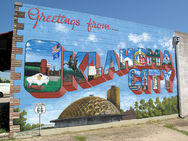National links: Oklahoma City, here we come

Photo by Matthew Rutledge on Flickr.
If you want to enjoy a good job and an affordable place to live, you might want to head to Oklahoma, Nebraska, or Iowa. San Jose is apparently the weirdest city in the US, and the people who usually build the freeways in Texas are supporting the idea of tearing one down in Dallas. Check out what’s happening around the country in transportation, land use, and other related areas!
Not many housing options: Even when people are willing to make tradeoffs to live in places where housing prices are sky high, it’s hard to find quality of life, a good jobs, housing that’s affordable all in one place. So hard, in fact, that only three cities in the United States have all 3: Oklahoma City, Omaha, and Des Moines. That’s according to a study from the Oregon Office of Economic Analysis. (Gizmodo)
Weird city science: Cities are full of people and activities that many would label “weird.” But which one is actually most different from the county’s norm? Based on factors ranging from how many foreign-born workers there are to how many people don’t own a car, cotton economist Lyman Stone says it’s San Jose, and that Oklahoma City is the least weird. (Washington Post)
Tear down this freeway: Texas’ department of transportation, unsurprisingly, loves to build freeways. But in a recent report on what to do with an obsolete downtown Dallas freeway spur, the agency opened up the possibility of thinking less like a typical highway department and more like urban designers, with an option to tear down the freeway and let the city reclaim the land. (Dallas Morning News)
The end of big infrastructure: While there are a few possibilities for national-scale projects we’d benefit from, this author argues that the era of building big infrastructure is over. There just isn’t much we could invest in that could bring the return of our railroad or interstate system, meaning smaller, local projects and maintenance should be our priorities. (Transportist)
Ride hailing real talk: Right now, ride hailing companies like Uber and Lyft are giving cities a binary set of options: do what we want, or we’ll leave. That isn’t productive, and the conversation needs to change if there is to be a solution that serves both city residents and companies that want to innovate. Luckily, there are examples of good partnerships. (Sidewalk Labs)
Seattle’s big slice: In the Puget Sound region, where Seattle is, there are five “taxing areas” within three counties. The Sound Transit projects that each receives are reflective of how much each pays in taxes, and the organization’s leader (a former FTA administrator) says it’d be best to have everyone pay for a new tunnel in downtown Seattle because the entire network will benefit from it. (Seattle Times)
Quote of the Week
“It’s possible San Francisco may have unwittingly demonstrated what I’m calling the Indiana Jones Theory of Housing Regulation. The idea is that when cities increase the burden on new development, whether through inclusionary zoning, expiring tax breaks, or new building codes, they create a deadline boom, as builders rush to get approval before the new laws can take effect. Like Indiana Jones, builders try to get through before the door closes.” - Slate’s Henry Grabar, explaining his Indiana Jones theory of housing regulation.
